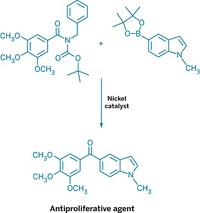Advertisement
Grab your lab coat. Let's get started
Welcome!
Welcome!
Create an account below to get 6 C&EN articles per month, receive newsletters and more - all free.
It seems this is your first time logging in online. Please enter the following information to continue.
As an ACS member you automatically get access to this site. All we need is few more details to create your reading experience.
Not you? Sign in with a different account.
Not you? Sign in with a different account.
ERROR 1
ERROR 1
ERROR 2
ERROR 2
ERROR 2
ERROR 2
ERROR 2
Password and Confirm password must match.
If you have an ACS member number, please enter it here so we can link this account to your membership. (optional)
ERROR 2
ACS values your privacy. By submitting your information, you are gaining access to C&EN and subscribing to our weekly newsletter. We use the information you provide to make your reading experience better, and we will never sell your data to third party members.
Synthesis
Oxathiaborolium debuts as a chiral Lewis acid catalyst
Replacing nitrogen with sulfur in a known borenium catalyst increases acid-base interactions, expands scope of Diels-Alder cycloadditions
by Stephen K. Ritter
January 2, 2017
| A version of this story appeared in
Volume 95, Issue 1
Oxazaborolidines are boron-based Lewis acids with a bicyclic nitrogen-boron-oxygen core that are known for being efficient chiral catalysts. In particular, they are useful in facilitating enantioselective Diels-Alder cycloadditions and an array of other types of addition reactions—part of the standard repertoire of organic synthesis. A research team in Taiwan has now added a new twist to these borenium catalysts by replacing nitrogen with sulfur (Org. Lett. 2016, DOI: 10.1021/acs.orglett.6b03147). Inspired by earlier work on oxazaborolidines, Singam Naveen Kumar and Rong-Jie Chein of Academia Sinica and Isaac Furay Yu of National Taiwan University reasoned that sulfur, which is a weaker electron donor than nitrogen, should increase the Lewis acidity of the central boron atom and offer new synthesis opportunities. The resulting oxathiaborolium, which is no easier to say or spell than its predecessor, indeed facilitates enantioselective Diels-Alder reactions, such as the cycloaddition of cyclopentadiene with various acrylates and cyclic enones. But the new catalyst is effective with a broader range of acrylates than oxazaborolidines. The researchers believe oxathiaborolium is the first reported example of a sulfur-stabilized borenium Lewis acid and could pave the way for expanding the applications of chiral sulfur ligands in organic synthesis.





Join the conversation
Contact the reporter
Submit a Letter to the Editor for publication
Engage with us on Twitter